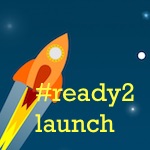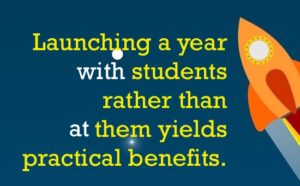Achieving escape velocity with students as partners
 Congratulations for making it through the first month of school! Whether it’s your first year as an educator or your thirty-first, the launch of the school year is a special — and especially challenging — time.
Congratulations for making it through the first month of school! Whether it’s your first year as an educator or your thirty-first, the launch of the school year is a special — and especially challenging — time.
It’s worth taking a moment to reflect and imagine how to build on what you’ve started.
The makings of a successful launch
We designed the posts in our #ready2launch series to help you think about practical strategies for getting your classrooms safely off the launchpad with the payload of essential building blocks for a successful year.
- Scott Thompson wrote about developing a strong teaching team and ways to recruit students into leadership roles in your classrooms.
- Rachel Mark mapped out a strategy for running your own student-led open house and a high-impact advisory program.
- Audrey Homan described how to explore students’ identities as a precursor to an empathetic learning community.
- Katy Farber emphasized student involvement in establishing classroom norms and routines, as well as the design of flexible learning spaces, both of which lay important groundwork for implementing student-driven project-based learning or service learning programs.
- Life LeGeros made compelling cases for involving students in the design of makerspaces and the implementation of your own genius hour.

The second stage of flight
But getting off the launchpad is only the first step.
Experienced teachers have learned that efforts to create a smooth-running learning community must be sustained, just as rockets need a second-stage booster to achieve escape velocity and reach the tranquility of orbit. (Of course, tranquil may not be the best way to describe even the most finely tuned middle grades classrooms.)
Yet continually searching for ways that students and teachers can know each other better, steadily reinforcing collaborative norms and routines, exploring new leadership opportunities for students, and most importantly, engaging students’ voices all along the way, are the lifeblood of a truly successful year.
True communities are not imposed, nor are they the product of shrewd manipulation.
They emerge from genuine collective action beginning with students as leaders, like designing the classroom space, or establishing norms and routines. And ultimately, working toward more personalized and flexible pathways is a fool’s errand when we shut them out of the process. Susan Hennessey’s penetrating post about students’ redesign of personal learning plans is a powerful case in point.
[huge_it_slider id=”9″]
Launching a year with students rather than at them yields very practical benefits.
Students can help us more quickly arrive at designs and practices which are responsive to their needs. Their insights can serve throughout the year as thrusters to stabilize a classroom before it spins out of control.
They can help us maneuver delicately as we join up with new community partners or make critical adjustments on a path toward project-based learning, makerspaces, or genius hours.
Listen again to the quotes from these teachers who attended the PLP (Re)Design event:
“The PLP redesign was a real eye-opener in seeing how students would prefer to create their own projects. It reminded me that, when given the right opportunities, students will jump right into a project and take the responsibility for their own learning and achievement.”
“It reminded me that student voice needs to factor in much more than it currently does in our plan. We need to revisit what are our non-negotiables. Can we let students choose the platform? Their goals? Ways of reflecting? Etc.”
Onward together
Yet the more powerful benefits stem from students and teachers coming to know one another in new ways.
The trust and sense of efficacy students gain when their opinions are honored positions them to take risks and stand by adults as we take risks of our own. Teachers come to appreciate students as insightful allies in the complicated work of teaching and learning.
And the classroom community starts to resemble the society we would wish for each other: one in which we all feel heard, respected, and empowered in a joint pursuit of something better.
A powerful and fulfilling school year is at once an endless journey and one made up of a thousand small steps, beginning, perhaps, with one of the questions Elena Aguilar suggests we ask our students: What do you wish was different about school? Describe a moment in school last year when you felt really engaged. What do you wish I would ask you so that I can be a good teacher for you?

